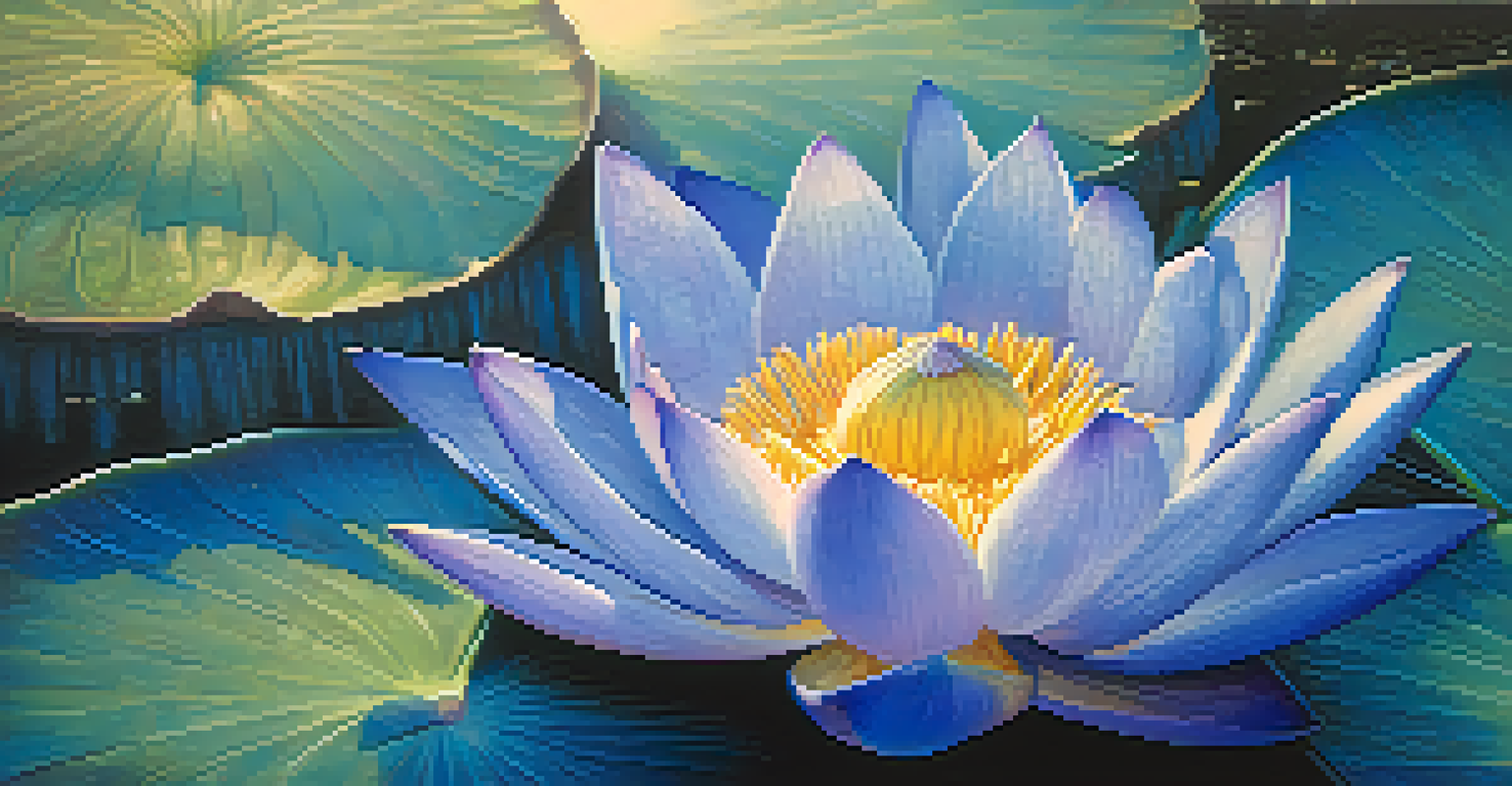The Influence of Entheogens on Ancient Mythology and Art

Understanding Entheogens and Their Historical Context
Entheogens are substances that inspire mystical experiences and are often used in spiritual rituals. Historically, cultures across the globe have utilized these substances to connect with the divine, explore consciousness, and enhance creativity. From the ancient Greeks with their use of kykeon in Eleusinian mysteries to the indigenous peoples of the Americas consuming peyote, these practices highlight the deep roots of entheogenic use in human society.
The experience of the sacred is a doorway to the divine, and entheogens can often serve as a key to unlock that door.
In ancient times, the lines between the sacred and the everyday were often blurred, with entheogens playing a pivotal role in religious ceremonies. They were believed to facilitate communication with gods or ancestors, providing insights that influenced everything from moral codes to artistic expression. This cultural significance is evident in various mythologies that feature gods or heroes who gain wisdom or power through the consumption of these substances.
By examining the historical context of entheogens, we can appreciate how they shaped the spiritual landscapes of ancient civilizations. These experiences often translated into art and mythology, reflecting a worldview that celebrated the interconnectedness of life, nature, and the divine. Understanding this interplay sets the stage for exploring specific examples of entheogens in mythology and art.
Entheogens in Mythology: Divine Inspiration and Wisdom
Many ancient mythologies feature narratives involving entheogens that symbolize a quest for divine knowledge or transformation. For instance, in Hindu mythology, the consumption of soma is depicted as a means to achieve immortality and divine insight. This celestial drink, often described in the Rigveda, was believed to grant poets and seers the ability to access profound truths about existence.

Similarly, the Greek myth of Persephone and her descent into the underworld can be interpreted through an entheogenic lens. Her journey is often associated with the consumption of the mysterious kykeon, suggesting a deeper exploration of death, rebirth, and the cyclical nature of life. Such myths not only highlight the transformative power of entheogens but also illustrate how they served as metaphors for human experiences.
Entheogens and Spiritual Practices
Entheogens have been historically used across cultures to facilitate mystical experiences and connect with the divine.
These stories reveal that entheogens were not merely substances consumed for pleasure but rather tools for spiritual enlightenment. They played a crucial role in shaping cultural narratives that addressed existential questions and the human condition, making them an integral part of ancient mythology.
Artistic Expressions Influenced by Entheogenic Experiences
Art has always been a medium for expressing the ineffable, and entheogens have significantly influenced various artistic movements. Ancient artifacts, murals, and pottery often depict scenes that suggest altered states of consciousness, possibly induced by these substances. For example, the intricate designs found in Mesoamerican art reflect a deep connection to the spiritual experiences associated with entheogenic plants like mushrooms and peyote.
Psychedelics can help us remember who we are, not as individuals, but as part of the greater cosmos.
In ancient Greek culture, pottery often illustrated mythological themes, including those related to Dionysus, the god of ecstasy and wine. The use of wine, which is considered an entheogen, in rituals and celebrations was believed to open the mind to divine inspiration. Artists of the time captured these moments, creating works that conveyed the emotional and spiritual highs of these experiences.
This connection between entheogens and art continues to resonate today, inspiring contemporary artists to explore similar themes of transcendence and altered perception. By drawing from ancient practices, modern creators honor the legacy of entheogens as catalysts for creativity and self-exploration, further intertwining art with the mystical dimensions of human experience.
Symbolism of Entheogens in Ancient Art and Rituals
Entheogens often carry rich symbolism in ancient art, serving as a bridge between the material and spiritual realms. Common motifs, such as serpents, mushrooms, or plants, frequently appear in artwork from various cultures, hinting at their entheogenic qualities. In many cases, these symbols were not only decorative but also served as a visual language communicating deeper spiritual truths.
For instance, the serpent in Mesoamerican cultures is often associated with regeneration and the cyclical nature of life, echoing the transformative experiences that entheogens provide. Similarly, the representation of mushrooms in cave art suggests a recognition of their psychoactive properties, linking them to spiritual journeys and visions. Such symbolism indicates that ancient peoples understood these substances as more than mere plants; they were viewed as gateways to higher consciousness.
Symbolism in Ancient Art
Ancient art often incorporates symbols related to entheogens, representing their transformative and spiritual significance.
Through analyzing the symbolism present in ancient art, we gain insight into how entheogens were integrated into the cultural fabric of societies. These symbolic representations reflect the reverence and respect attributed to the transformative potential of entheogens, framing them as sacred tools for accessing higher states of being.
The Role of Shamanism in Ancient Cultures and Art
Shamanism, a practice prevalent in many ancient cultures, often involved the use of entheogens to facilitate healing, divination, and communication with spirits. Shamans, regarded as intermediaries between the human and spiritual worlds, utilized these substances to alter their consciousness and gain insights. Their journeys were frequently depicted in art, illustrating the shaman's connection to the divine and the natural world.
Artworks from various cultures, such as Native American and Siberian tribes, often depict shamans in trance states or surrounded by animals and spirits. These images not only represent the shaman's experiences but also serve as visual narratives of the transformative power of entheogens. They encapsulate the belief that these substances enabled individuals to access hidden realms of knowledge and healing.
By understanding the role of shamanism in ancient cultures, we see how entheogens were central to spiritual practices and artistic expressions. This relationship underscores the importance of these substances in shaping cultural identity, belief systems, and the creation of art that reflects the profound connections between humanity, nature, and the divine.
Cultural Variations in the Use of Entheogens
Across the globe, different cultures have approached the use of entheogens in unique ways, reflecting their distinct beliefs and practices. In ancient Egypt, for example, the blue lotus flower was revered for its psychoactive properties and was often associated with creation and rebirth. This flower appeared in various forms of art and decoration, symbolizing a spiritual awakening and connection to the divine.
In contrast, the Andean cultures of South America have a rich history of using coca leaves and ayahuasca in their spiritual traditions. These substances were not only viewed as medicinal but also as sacred tools for connecting with ancestors and the spirit world. Artistic representations from these cultures often depict the profound experiences and visions encountered during such ceremonies, emphasizing the importance of entheogens in their worldviews.
Modern Interest in Ancient Traditions
Today, there is a growing fascination with entheogens as tools for personal growth, echoing ancient practices of healing and creativity.
These cultural variations highlight the diverse ways in which societies have integrated entheogens into their spiritual and artistic practices. By examining these differences, we can appreciate the shared human desire to explore consciousness and the divine, fostering a deeper understanding of our collective heritage.
Modern Reflections on Ancient Entheogenic Practices
In recent years, there has been a resurgence of interest in entheogens as tools for personal and spiritual growth. This modern exploration often draws inspiration from ancient practices, where substances were used in sacred contexts to foster healing, creativity, and connection. Today, many people are revisiting these traditions, seeking to understand the profound insights that entheogens can offer.
Art and literature reflecting contemporary experiences with entheogens echo the themes found in ancient mythologies. From the vibrant colors and surreal imagery of psychedelic art to the introspective narratives in literature, modern creators are channeling the transformative power of these substances. This revival highlights a desire to reconnect with the wisdom of the past while exploring the potential of entheogens in contemporary society.

By looking back at ancient uses of entheogens, we can better understand their role in shaping human experience throughout history. This ongoing dialogue between past and present not only enriches our appreciation of ancient cultures but also encourages us to consider how these practices can inform our own spiritual journeys today.